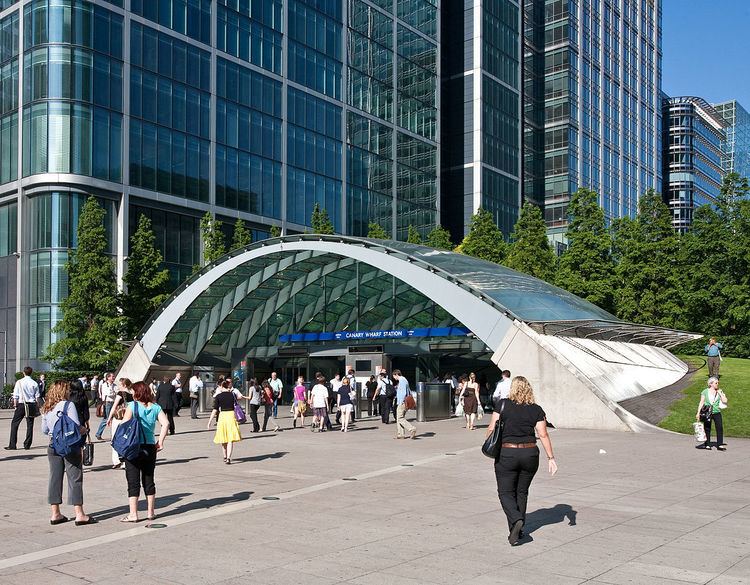Accessible Yes 2012 48.04 million Opened 1999 Engineering firm Arup Group | Fare zone 2 2013 50.05 million Number of platforms 2 Architect Norman Foster | |
 | ||
Similar London Underground, Canary Wharf railway st, Canada Water station, Canary Wharf DLR station, North Greenwich tube station | ||
Canary wharf tube station at night
Canary Wharf is a London Underground station on the Jubilee line, between Canada Water and North Greenwich. The station, serving Canary Wharf, is in Travelcard Zone 2 and was opened by Ken Livingstone setting an escalator in motion on 17 September 1999 as part of the Jubilee Line Extension. It is maintained by Tube Lines. Over 40 million people pass through the station each year, making it second busiest on the London Underground outside Central London after Stratford, and also the busiest that serves only a single line.
Contents
- Canary wharf tube station at night
- insane underground station canary wharf tube station operation landfill episode 3
- History
- The station today
- Services and connections
- Line improvement
- In popular culture
- References
insane underground station canary wharf tube station operation landfill episode 3
History
Before the arrival of the Jubilee line, London's Docklands had suffered from relatively poor public transport. Although the Docklands Light Railway station at Canary Wharf had been operating since 1987, by 1990 it was obvious that the DLR's capacity would soon be reached. The Jubilee line's routing through Canary Wharf was intended to relieve some of this pressure.
The tube station was intended from the start to be the showpiece of the Jubilee Line Extension, and the contract for its design was awarded in 1990 to the renowned architect Sir Norman Foster. It was constructed, by a Tarmac Construction / Bachy UK Joint Venture, in a drained arm of the former dock, using a simple "cut and cover" method to excavate an enormous pit 24 metres (78 ft) deep and 265 metres (869 ft) long. The size of the interior has led to it being compared to a cathedral, and it has even been used to celebrate a wedding. However, the main reason for the station's enormous dimensions was the great number of passengers predicted; as many as 50,000 daily. These predictions have been outgrown, with as many as 69,759 on weekdays recorded in 2006.
In a 2013 poll conducted by YouGov, it was voted as the "Most Loved" tube station in London.
The station today
Above ground there is little sign of the vast interior: two curved glass canopies at the east and west ends of the station cover the entrances and allow daylight into the ticket hall below. The Jubilee Park, a public park is situated between the two canopies, above the station concourse. It had originally been intended that the infilled section of the dock would be reinstated above the station, but this proved impractical because of technical difficulties and the park was created instead.
As with the other below-ground stations on the Jubilee Line extension, both station platforms are equipped with platform screen doors.
Canary Wharf station has become one of the busiest stations on the network, serving the ever-expanding Canary Wharf business district. Although it shares its name with the Docklands Light Railway station at Canary Wharf, the two are not directly integrated (in fact, Heron Quays DLR station is nearer at street level). All three stations are connected underground via shopping malls. Out-of-station interchange within twenty minutes between any two of the stations entails no additional charge.
Canary Wharf can be used to reverse trains from both the east and the west. A scissors crossover west of the station allows trains from Stanmore to enter either the east- or west-bound platform at the station, and trains from Stratford enter the normal westbound platform and can use this scissors crossover to reverse back towards Stratford.
Services and connections
The station is located on the Jubilee line between Canada Water and North Greenwich in Travelcard Zone 2. The typical off-peak service, in trains per hour (tph) is:
Night tube services, running on Friday and Saturday nights, were introduced in October 2016. Trains run every 10 minutes on the entire line.
London Buses routes 135, 277 and the D prefix route D7 night route N550 and Coach routes 761, 762 763, 764, 769, 770, 781, 784 serve the station. In addition, bus route 277 provides a 24-hour bus service.
Line improvement
Canary Wharf station and the Jubilee line Extension itself were partly funded by the owners of the Canary Wharf complex, with the intention of making it more accessible to commuters. Only five years after the construction of the extension, capacity issues started becoming apparent and upgrades were required. The first step was the lengthening of the trains from 6 to 7 cars. This was done at the end of 2005. The second step was to replace the conventional Jubilee line signalling with the Thales S40 moving-block system. This was eventually introduced into service during 2011 after many delays and teething problems and allows a more intensive timetable to operate with 30 trains per hour running in the peaks.
In popular culture
On 9 January 2013, the station appeared on a £1.28 British postage stamp as part of a set commemorating the 150th anniversary of the first London underground train journey. The stamp's captions read "Jubilee Line at Canary Wharf" and "1999". The Canary Wharf stamp represented the most modern phase of the Underground in the set of six stamps.
The station was used as a location for some scenes of Danny Boyle's 2002 film 28 Days Later. In April 2016, Star Wars fans using Twitter commented that the station had apparently been used in a scene of the trailer for the film Rogue One.
